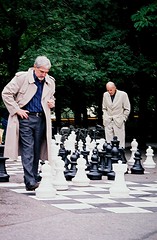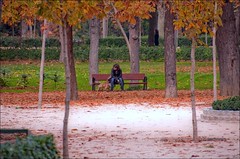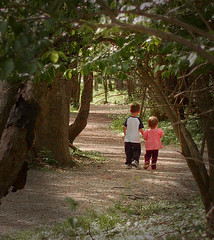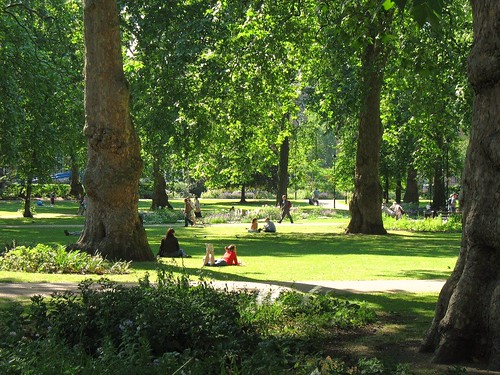Interested in how to think about city parks? Get this book

Posted May 7, 2010 at 1:32PM
Peter Harnik knows more about city parks than anyone else I know. And he has now put much of what he knows into a handy new book, Urban Green: Innovative Parks for Resurgent Cities (Island Press, 2010). I was using it as a reference literally within minutes of receiving my copy and, if you are interested in the topic, you’ll find lots in it to draw from as well.
By coincidence, a few days before the book came out, I called Peter, who heads the Center for City Park Excellence at the Trust for Public Land. I was working on a presentation featuring a neighborhood that has seen a spectacular amount of recent densification but, as far as I can tell, precious little in the way of new parks to serve the additional population. I was interested in whether there was a rule of thumb among park planners for how much park land should be provided to serve a given number of people.
 I spent the next several days in email and telephone conversation with Peter and his TPL colleague Ben Welle being gently told that I had asked a question they would prefer not to answer. It was a bit frustrating for me, but now that I have read Peter’s book I understand his point: he believes that formulaic approaches to thinking about parks do more harm than good, and the first half of the book is devoted to how such theoretical approaches fail in real-world situations.
I spent the next several days in email and telephone conversation with Peter and his TPL colleague Ben Welle being gently told that I had asked a question they would prefer not to answer. It was a bit frustrating for me, but now that I have read Peter’s book I understand his point: he believes that formulaic approaches to thinking about parks do more harm than good, and the first half of the book is devoted to how such theoretical approaches fail in real-world situations.
Along the way, Peter teaches the reader what one should consider in order to construct and manage a successful city park system: that different kinds of parks serve different functions; that different kinds of populations look to parks for different services; that parks and neighborhoods need each other to be successful; that parks in the suburbs may be created through conservation of existing undeveloped land, but most parks in cities need to be developed (New York’s Central Park may look like it was conserved, but in fact it was carefully planned and created).
Peter argues that each situation requires a planning “process rather than a standard” to address park needs and how to meet them. The elements of a good process include taking stock of current conditions, involving the public, assessing costs and benefits, a budget and timeline, an implementation assessment, and so on. Quantitative data are relevant (e.g., population density is the single most important factor in assessing park needs; spending per capita is more revealing than acreage per capita) but never dispositive.
The second part of Urban Green comprises chapters describing 15 ways of finding park space in the city. They range from buying park land outright to incorporating it into redevelopment schemes to making innovative use of rooftops, schoolyards, reservoirs and even cemeteries.  I don’t agree with all of them, necessarily (I’m not ready for someone to play Frisbee on my loved ones’ graves, but maybe that’s just me), but all have been put into place in one location or another, often very successfully. The point, I think, is that to restore our cities by bringing population back, we need to think about ways of providing them with parks, and we will need to think creatively to do so. Peter is a master at doing just that and, if it’s been tried somewhere, he can probably tell you how it worked out and why.
I don’t agree with all of them, necessarily (I’m not ready for someone to play Frisbee on my loved ones’ graves, but maybe that’s just me), but all have been put into place in one location or another, often very successfully. The point, I think, is that to restore our cities by bringing population back, we need to think about ways of providing them with parks, and we will need to think creatively to do so. Peter is a master at doing just that and, if it’s been tried somewhere, he can probably tell you how it worked out and why.
The book doesn’t back down from a number of hard insights, such as the fears that many citizens have about parks and urban spaces, that parks can undermine needed urban density as well as complement it, and that some people now use their own yards for functions that used to be supplied by parks, weakening support for parks in some places. For the most part, there are answers and approaches to these issues, and Peter illustrates them with examples.
If there’s a second edition sometime down the line, I would like to see more photos, drawings, and maps. There is a small middle section containing a few, and presumably there would have been more but for cost. But parks make great visuals, images give meaning to words, and the concepts introduced in the chapters would be better explicated if images were placed along with corresponding text.  The terrific “one principle and one illustration on each page” approach of the recently published Smart Growth Manual is one that I hope more writers in our field will emulate. I was also a bit surprised not to see mention of Savannah’s wonderful city squares – or Bloomsbury’s in London – as examples that our cities would do well to copy (of course London also has a spectacular network of large city parks, too, also not mentioned). Maybe it is because so much of my recent work has been at the neighborhood scale that these are the parks that interest me the most, but I would have liked to see more specific reference to them.
The terrific “one principle and one illustration on each page” approach of the recently published Smart Growth Manual is one that I hope more writers in our field will emulate. I was also a bit surprised not to see mention of Savannah’s wonderful city squares – or Bloomsbury’s in London – as examples that our cities would do well to copy (of course London also has a spectacular network of large city parks, too, also not mentioned). Maybe it is because so much of my recent work has been at the neighborhood scale that these are the parks that interest me the most, but I would have liked to see more specific reference to them.
I learned a lot from Urban Green, and I expect to continue to use the book as a reference – the chapters are logically arranged, there’s a good index and excellent bibliography, and Peter is a very good and thoughtful writer. And, above all, this is a tremendously important subject: cities and smart growth cannot succeed without the integration of nature and civic spaces.
Indeed, my own life would have turned out vastly different had there not been public tennis courts near my house when I was growing up, and as an adult I want no part of a city where I am unable to find a green place to relax, especially within walking distance. Urban Green tells us how to make it happen.
Move your cursor over the images for credit information.
